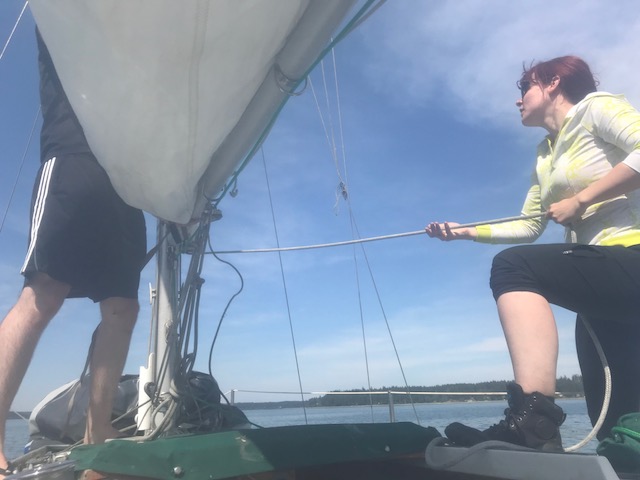First, get a sailboat.
You can buy a working 25ft-29ft sailboat on Craigslist for under $10,000. I wouldn't go much lower, however, unless you love spending all your free time fixing boats. You can also rent a boat on Boatsetter for about $300 per day.
Next, get a crew. Sailing experience is good, but more importantly, look for people who are helpful and on top of things and also fun to be around.
Buy your tickets to Toorcamp 2020.
Packing list for the boat (for Toorcamp, see Fbz packing list on Twitter):
Clothes:
- Warm layers (long underwear, sweatshirt, warm coat)
- Waterproof layers (raincoat or poncho, waterproof pants and hat if you have them)
- Warm socks
- Waterproof shoes or boots if you have them
- Sunglasses
- Bathing suit (water is cold, but it's exhilarating to jump in!)
- Gloves
- Warm hat
- Neck warmer (it could be warm or it could be REALLY cold and wet)
- light-weight long sleeved shirt for sun protection
- shorts and short-sleeved clothes for hot weather
- Hat for sun
Other:
- Headlamp
- Charging blocks for your phone (solar chargers work well)
- Power inverter if your boat has a motor
- Seasickness medication if you're prone to seasickness (I've heard scopalamine patches work well)
- towels
- linens/sleeping bag
- pillows
- Ear plugs
- eye mask
- Sunscreen
- Waterbottle
- OpenROV for spying on sea life
- kayaks and/or dinghy (I'm glad I brought both so that me and my crew were able to get to and from the boat as we pleased. Next time I'm bringing two kayaks and a motor for the dinghy)
- leatherman
Safety equipment
- VHF*
- Flares*
- Portable floatation devices (PFDs) for everyone on board*
- Knife, light, and whistle to tie to PFDs
- 1 PFD type IV (throwable ring or buoy)* (I recommend the lifesling)
- Horn, whistle, or bell*
- navigation lights*
- HAM radio
- Radar reflector (or radar)
- Epirb
Know before you go:
Be sure to get the nautical charts for Puget Sound (charts 18440) and the San Juans (charts 18421).
Get your Washington Boaters card (required if you're operating a boat of 15 horsepower of more in Washington)
Check the Washington marine report to see if there's a small craft advisory in place for any areas where you will be sailing. If there is, I would advise against sailing that day unless you have an experienced crew.
Know how to tie a bowline (useful for tieing things that will have strain on them
Things to keep in mind:
The water temperatures average 47 degrees in June. If you fall overboard, the shock from the cold water can immobilize you within minutes, so while you could hypothetically survive for an hour before succumbing to hypothermia, drowning due to cold water shock is the real killer. Wear a life jacket.
Do a practice man overboard drill with a floating item (if you see trash floating on the water you can do a good deed and get your man overboard practice).
Check the weather report each day that you're sailing for each part of the trip that you'll be doing. Wind and waves can vary greatly in different parts of the Sound.
If you're thinking about reefing the sail, you should already have reefed it.
Download the following apps:
Windy (thanks to Scotland for introducing me to this fantastic app!)
Boating US&Canada ($14.99)
Knots3D (great for practicing knots)
How long will it take?
Can you sail from Seattle in Toorcamp in one day? The distance from Seattle to Doe Bay on Orcas Island is about 70 nautical miles.
Warning: math ahead
A boat's speed is limited by a simple equation, known as "Hull speed." As a boat moves, it creates a wave in front of it. Once the wave in front of the boat is longer than the boat itself, it requires exponentially more power to make the boat move faster.
Hull speed is the speed at which the wavelength of boat's bow wave (the wave that forms at the front of the boat as you displace water) is equal to its length. Hull speed (in knots, or nautical miles) equals 1.34 times the square root of the waterline length in feet (HS = 1.34 * √LWL). I have a 29-foot boat with a waterline length of 22 feet, so its hull speed works out to about 6.2 knots (HS = 1.34 * 4.69).
That means I rarely travel much above 6.2 knots, unless I have a current pushing me. If I were to have good winds and time the currents correctly, theoretically I could travel at 7 knots for 10 hours and arrive in one long, sunburnt day.
There are only two mooring balls available in Doe Bay itself, but it's also possible to anchor out.
Alright, hopefully that was educational! See you in two years!





